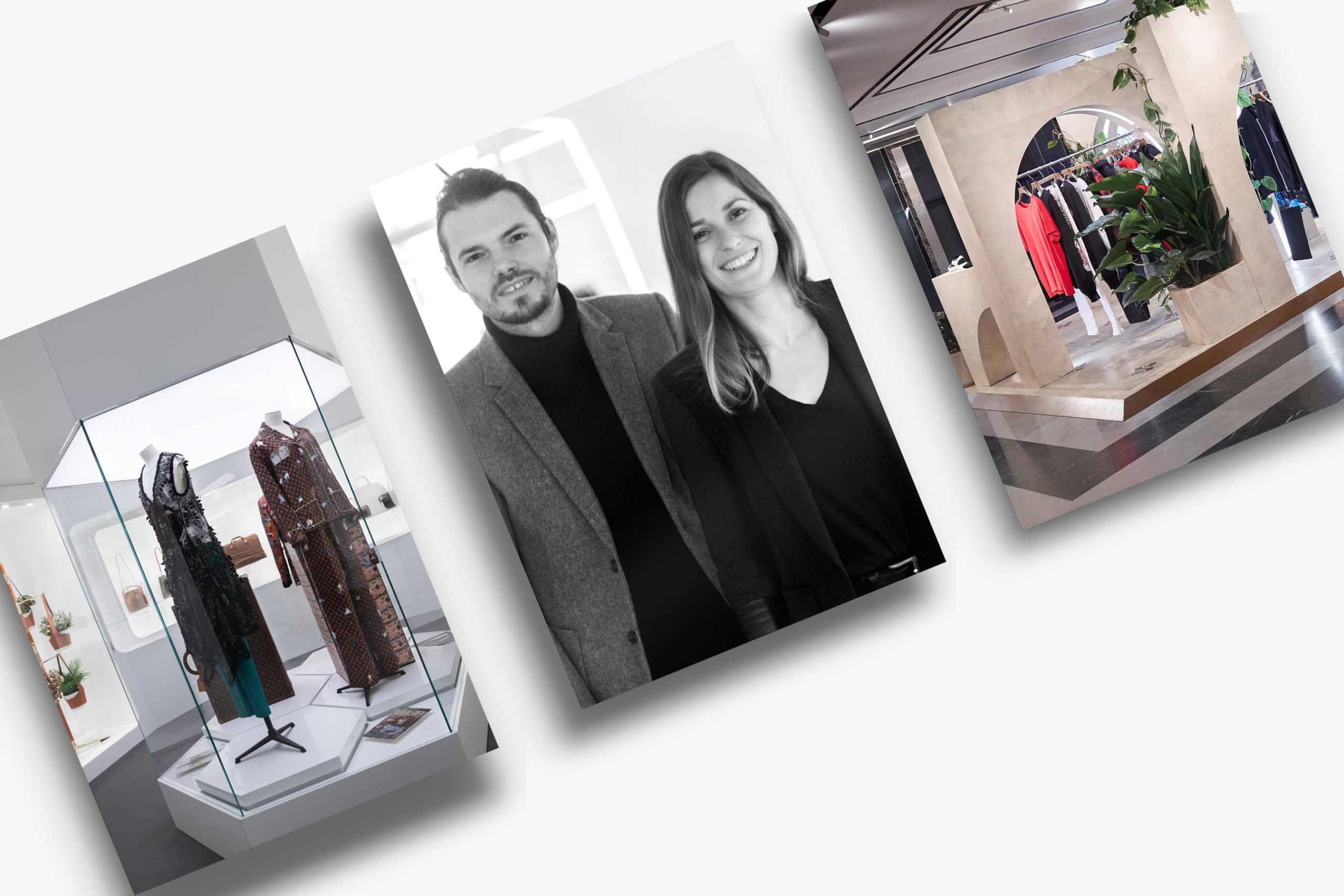NOCOD Studio: The Design Duo whose Alchemy has Created Magic for Luxury Fashion
By Angela Baidoo
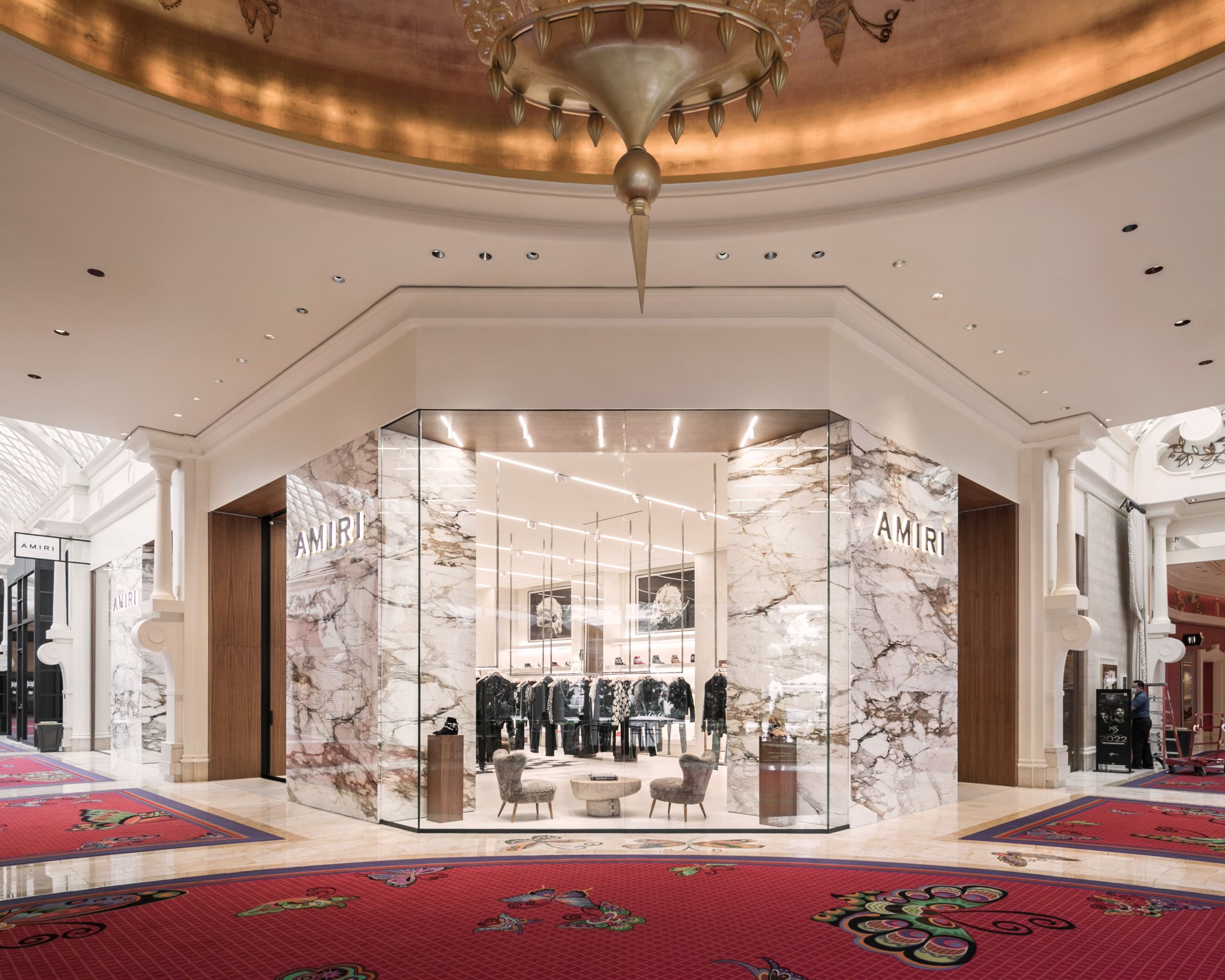
When we enter a luxury space, whether it’s a store in Los Angeles or a pop-up exhibition in Bangkok, very rarely do we consider who is behind the design. But post-pandemic – and the premature predictions of the death of the store – brands and consumers alike are realizing the importance of these spaces to discover, experience, and build community.
This is where NOCOD Studio have made their name, roughly translated to “No Code”, Floriane and Baptiste Dosne met in 2006 as architecture students, and founded their agency in 2015, building a reputation for crafting ephemeral spaces internationally, and perennial projects which harness a visual vocabulary, merging heritage and innovation for some of the most storied luxury brands across fashion, interiors, scenography, and exhibitions.
Speaking to The Impression Floriane and Baptise discuss how they learned to both master then manipulate the codes of architecture to create spaces which evoke emotion, are ‘rich in experience’, and bring people together.

Angela Baidoo: Can you tell us a bit about how you first came to know each other and why you decided to start the studio?
Floriane Dosne: We have known each other for almost 20 years now, so we are like a duo in both our professional and personal lives.
Baptiste Dosne: We met during our diploma (Floriane at École Nationale Supérieure d’architecture de Paris-Belleville and Baptiste at École Nationale Supérieure d’architecture de Paris- La Villette), where we had to work very hard, but our time in architecture school was very collaborative. So, in our early months and years we learned to work together, and now it’s part of the DNA of our relationship.
Floriane Dosne: We had a few opportunities to work together after our diploma, and then it was organic how we decided to fund NOCOD, it was a continuation of our work together.
Baptiste Dosne: The way in which we arrived in fashion and luxury was also by accident. When you come from the architecture field – Floriane is an architect, and I’m an interior designer – where timelines for projects are very long, to directing projects during fashion week, where we then had tons of projects at the same time, we had to learn about everything fast.
Floriane Dosne: But, it was a fantastic time, where we learned a lot and it was also a booster for our career.
Baptiste Dosne: We learned to understand the codes of every house we worked with, to develop many different kinds of visual language, from scenography that was super extravagant, to the highly minimal.
Floriane Dosne: From the contemporary to the highly traditional, and from small scale to large scale, everything was possible.
With Vuitton we talked about their history, but with futuristic architecture. We used this as a narrative tool during the exhibition, contrasting between their heritage and the contemporary products inside.
– Baptiste Dosne
Angela Baidoo: When you say you came to luxury and fashion by accident, can you explain what that experience was like, and who your first client was?
Baptiste Dosne: One day we would be working for Elie Saab, then a fashion show for Chloe, and the day after we would finish a Kanye West show, but production companies are like that, so many projects at the same time, and all are very different.
Floriane Dosne: We created NOCOD because we wanted to do something a bit different, to take more time with our projects, and not to be in such a hurry all the time. Then we had this amazing opportunity to work for Louis Vuitton and the main project for them was the Time Capsule.
Baptiste Dosne: This was before (then during) Virgil Abloh’s arrival and the project at that time was a huge trunk in the middle of different cities. It was the beginning of this new approach ‘Local Temporary’, so they were very open to something new, and we took the opportunity to design the spaceship, something that would ‘break the code’.
That’s also why, of course we are named NOCOD (No Code). In our early career, we were learning the codes, learning how to follow, and how to play with them. But with NOCOD, it’s our responsibility to sometimes forget about the rules.

Angela Baidoo: Thinking about your work on the retail and interiors side of the industry. What would you say are some of the key ways you are elevating the customer experience and encouraging them to spend time within the spaces that you’ve created?
Baptiste Dosne: First, we need to consider that there are those who don’t want to spend too long in-store, and those that do, we need to cater to both types of people. This means we must create a strong first impression and think about the big picture. We create strong visual appeal inside these spaces, so people can go straight to what they want. But our job is to create beautiful, rich surroundings, so, people can discover the collections. And for those customers who are already part of the brand community, it’s our responsibility to make a space which resonates.
After the pandemic, we found that it was important to offer the customer a place to rest, to spend time, to enjoy, and to be together.
It’s part of luxury now, where with each project we design we don’t include any useless gestures (i.e. anything unnecessary), our designs are tightly controlled, we choose every shape, every material, the atmosphere is the most important.
Angela Baidoo: How have you learned to balance the needs of the brands you have worked with and the demands of today’s customer?
Baptiste Dosne: We have been very lucky to work with strong creatives, who have been really involved in the process. We tend to bring our creative ideas to the table, and the client brings their ideas, and we fuse the two to get the best project outcome.
Floriane Dosne: We come with all our expertise and experience, but we listen to the client and their needs, and because we have worked on international projects, we have been able to explore working with different kinds of customers. I think it’s interesting to work in this global way.
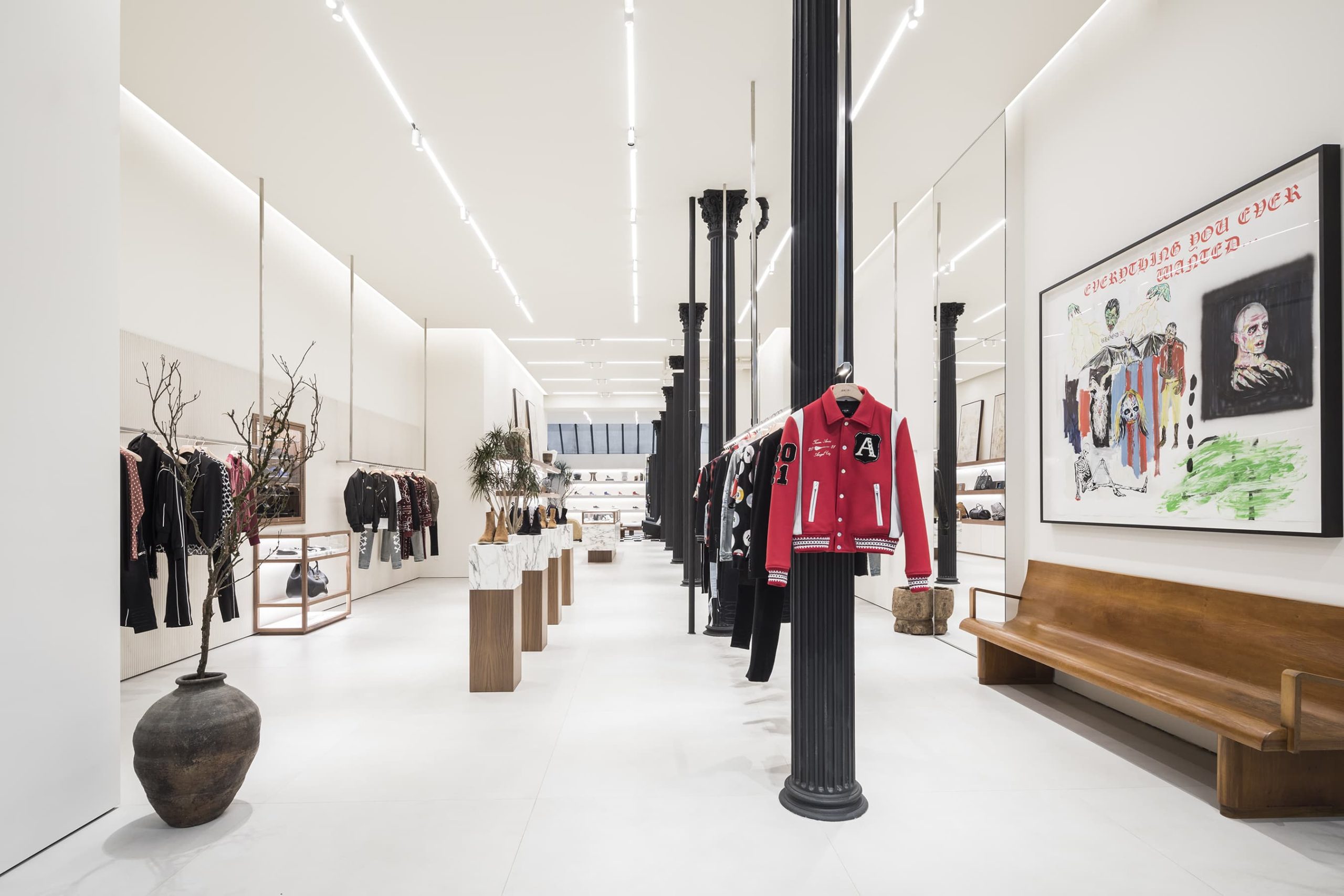
Angela Baidoo: There was a lot of talk about the ‘Death of the Store’ during 2020, but as restrictions loosened these spaces became key for discovery and experience, have you noticed any changes to what brands are seeking for the interior design of their stores?
Baptiste Dosne: It’s an interesting question, because we have noticed in some areas, like the US, they have gone back to normal.
Floriane Dosne: Yes, but in Asia, it’s a totally different story. But for brands it’s about creating that community feeling, this is what has become more important than ever. People also need to touch the garment, especially as we didn’t have the right to do that for two years.
Baptiste Dosne: For retail, I also think that real spaces are important. We know the digital side of the business is huge for them, but people need to be together. We can say that the experience (for the customer) is elevating, project after project.
Floriane Dosne: The customer experience is a key subject for the clients and projects we work with now.
We come with our expertise and experience, but we listen to the client and their needs, and because we have worked on international projects, we have been able to explore working with different kinds of customers. I think it’s interesting to work in this global way.
– Floriane Baptiste
Angela Baidoo: From your previous work, we can see that the physical experience is very important, how have you incorporated digital elements, whether that be smart mirrors or touch screens, as part of the ‘Store of the Future’ narrative?
Baptiste Dosne: For each brand, the store is a statement and we need to question if it should be less about digital and more about creating and building a story. For exhibitions, it is a crucial element because we use it to build the visual surroundings, we use a lot of digital for showcases, especially for smaller objects to give them the right scale when people visit the space. It is a crucial tool to create impact.
We have also found its less of a demand than it once was, as before everybody wanted to be digital – huge screens everywhere – and now it’s more important to incorporate real art pieces, for example. It’s key to have more experiential objects in a retail space, over just digital, because anyone and everyone can do digital.
Angela Baidoo: The Amiri store interiors lean on a minimalist aesthetic and a sense of California cool, yet they also convey a warmth and emotion, how were you able to achieve this for the brand?
Baptiste Dosne: The process started with the story of the brand, it was very important to identify crucial materials to suit that – California – narrative, the precise type of wood, the way we use stone, and also vegetation.
Floriane Dosne: Yes, the vegetation must blend with the architecture.
Baptiste Dosne: It’s a very welcoming space, that was one of the first things everybody had in mind, that, and it had to be very open.
Angela Baidoo: What would you say are the key ingredients for a successful collaboration, especially between designers that work across different mediums?
Floriane Dosne: With collaboration you need to have the ability to listen and to work with others, and ultimately use your intuition to find the right answers.
Baptiste Dosne: It’s part of the magic of our job, but for good collaboration we must trust in the brand too, and feel committed to their message.
Angela Baidoo: I want to just touch on digital again and ask, if you were unbound by the physical and could develop a space in the Metaverse, what would you like to create?
Baptiste Dosne: Well, our work is mostly virtual until it’s built.
Floriane Dosne: And for me I had a bit of a hard time figuring out what it was (the Metaverse). I had a lot of discussions with friends to try to understand what it is exactly, but now I get it.
Baptiste Dosne: I am very curious about crypto, and that type of technology. We are very curious people as it’s part of our job to be curious, so I think this is something we will possibly look to explore in the next year.
Angela Baidoo: I saw that you like to start the creative process with hand drawings, is this traditional method an important part of your process, and where does technology come into play?
Floriane Dosne: We use a lot of 3D tools as part of our process.
Baptiste Dosne: We work in a world of detail, luxury is about the details, so we are clearly details-focussed too, and 3D rendering is the most precise way to depict things, but if we need to express something very quickly or in a natural way, we won’t hesitate to use sketches. It’s universal, and no matter if its badly drawn it’s still a super-efficient part of our process.
Angela Baidoo: You have created exhibitions and interiors for brands from Miami to Bangkok, how much does the location influence or inspire your work?
Floriane Dosne: First, it’s a source of inspiration as is everything that surrounds us. The city, the locations, the design of the architecture around it, and the colours of everything. But, for retail, the location is a way to singularise the project within this global community.
Angela Baidoo: Speaking of inspiration are there any artists, architects, or other areas of popular culture that have inspired your work.
Floriane & Baptiste Dosne: Our influences have included Le Corbusier, a visionary, Mies van Der Rohe for the purity of lines, Tadao Ando for the emotion in the composition, and of course John Lautner and Richard Neutra. We are also influenced by artists beyond architecture itself, Benjamin Millepied (choreography and architecture have a lot in common), Larry Bell for his exploration of colour and materials, and photographer Jungjin Lee for textures, among many others.
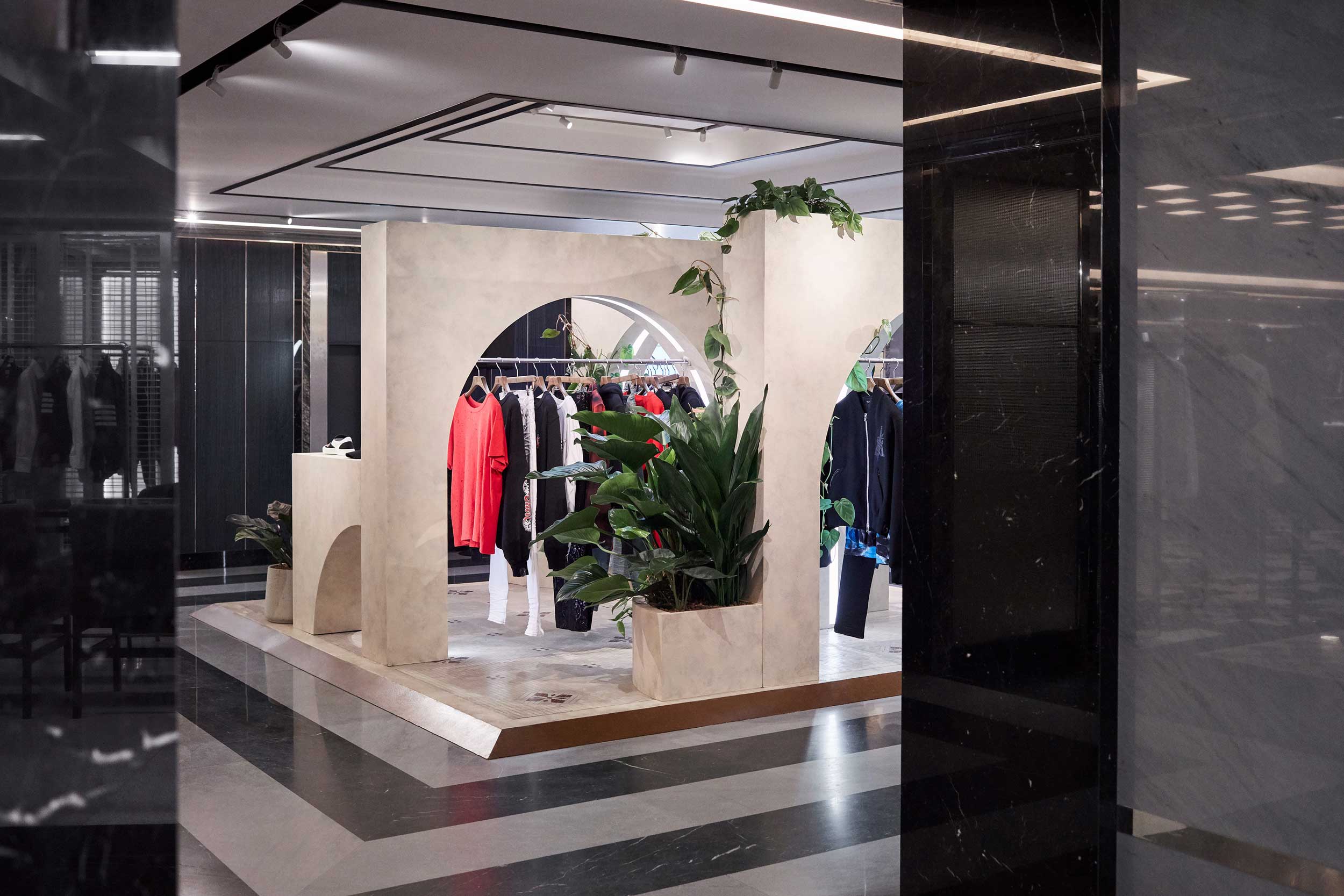
Angela Baidoo: Space and space exploration has been a feature of your work in the past (such as Sacai’s Mars inspired set design), why has this served as a reference point for you both?
Baptiste Dosne: It’s not necessarily a main reference in terms of aesthetic, but we have just come from Florida where we visited Cape Canaveral and the Kennedy Space Centre as I am a huge fan. It’s also the perfect place to witness heritage and innovation at the same time.
You could also say it’s related to our childhood, because for us to be good architects we have to be like children every day.
We are two people who design things very carefully, but inside we are still children, and space is part of that.
– Baptiste Dosne
Floriane Dosne: Again, it’s a universal topic which connects a lot of people. It offers a strong vocabulary for form and materiality.
Baptiste Dosne: Light, for example, we haven’t talk about light yet. But as we come from the scenography and fashion field, light is so important. We use it to create architectural elements in our exhibition projects, it helps people to read the space, to go where we want them to go, to encourage them to go and look at things. It’s a way to gently take people by the hand and lead them through the space, it also works perfectly in retail too.
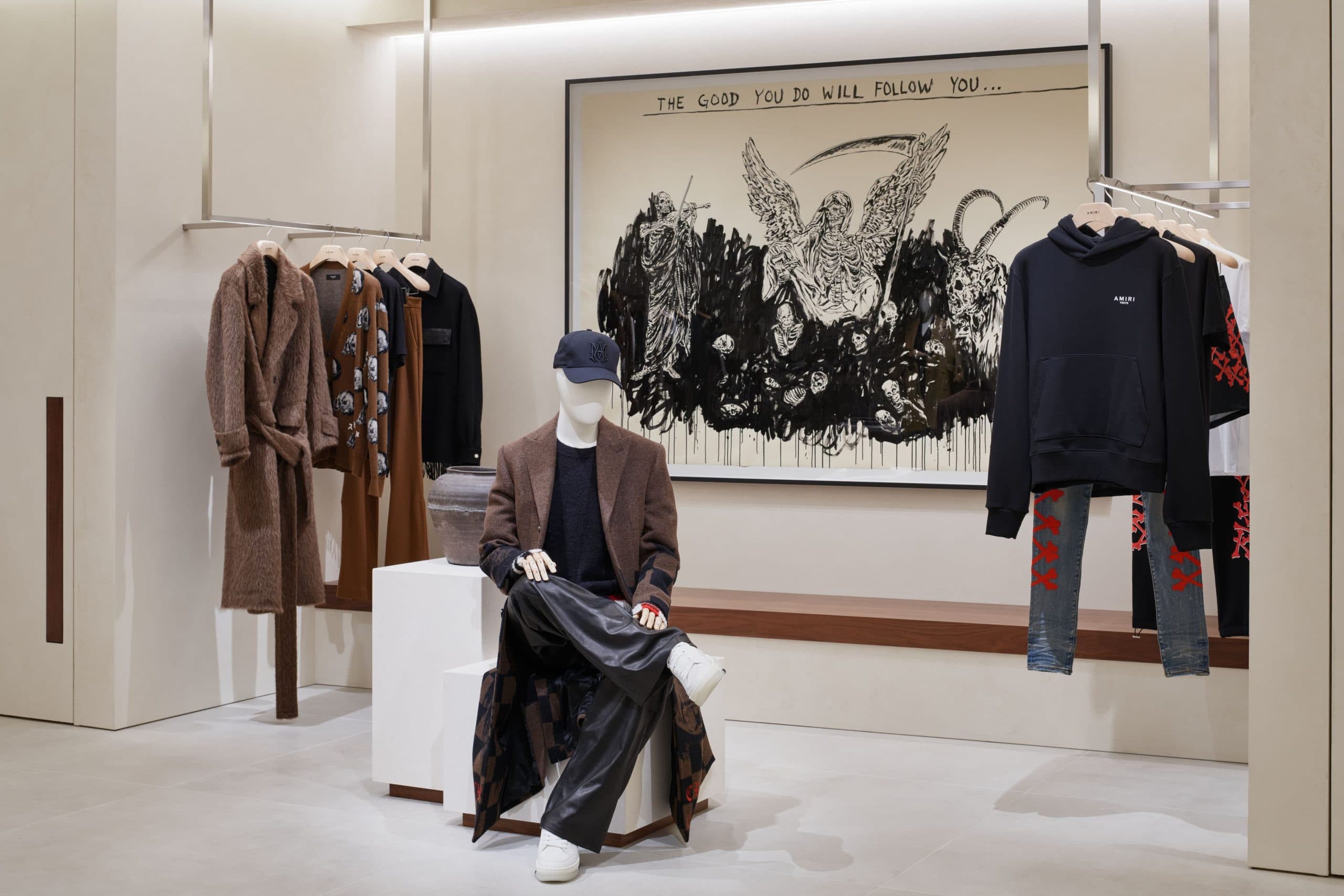
Angela Baidoo: The Safari armchair, which was developed in collaboration with Marine Bedouin, is a hyper-tactile object that is truly unique, can you explain what gave you the inspiration to merge animal and plant, and why the project was so long in the making?
Floriane Dosne: In our design and research process, the most important aspect is the story. And we wanted to design an object that could interact with the environment, and in the safari chair the beginning of the project was the story of this game between heritage and innovation, how can we interpret/re-interpret this object.
Baptiste Dosne: I did history studies before architecture, as my other dream before architecture was to be an archaeologist, so maybe that’s a part of the process, as we loved digging into the safari chair history, to use it as a tool to reveal the relationship between man and nature, its violence even. Using this research as a tool to create something beautiful which is also very sensory. This balance between heritage, history, and innovation helped us find new ways to take a contemporary approach.

Floriane Dosne: This piece was about interrogating the complexity of the relationship between man and nature, and all of our violent history, and how we can reconcile with that. We just want to ask questions, and make people react.
It was a long process because the lizard part was handmade by us, we learned to experiment and try different methods.
Baptiste Dosne: I believe it was important to you (Floriane), to craft things by hand. In our job, even if we design by hand, and we touch the material, we are not the builder. But this was a very important project for us, we wanted to go back to something that was important to ourselves too, in the building/making process itself.
The collection is designed but not finished, and we hope that next year will be the full reveal.

Angela Baidoo: You have worked on retail interiors, exhibitions, object design, and runway production, are there any other industries or areas you would like to explore in the future?
Baptiste Dosne: Well, I am very curious about the Metaverse, I want to be part of it in one way or another. We also have yet to develop any hotels, and this is something we are interested in developing.
Angela Baidoo: When you have time away from your work, where are the places and spaces you like to visit to recharge and get inspiration for your next project/s?
Baptiste Dosne: When we went to the U.S., we visited some of our projects as part of our vacation, but we know we have to work on that. And resting time, we are not good with that.
Floriane Dosne: Yes, we have family resting-time, but we are urban, so we love to visit cities.
Baptiste Dosne: To hang out, but to also get lost. This is something we do on our holidays; we love to be lost in cities. Even with children it’s doable, and when you don’t have a clear plan, you can peacefully look at buildings, study the details. It’s a bit cliché but it’s something we love to do.
